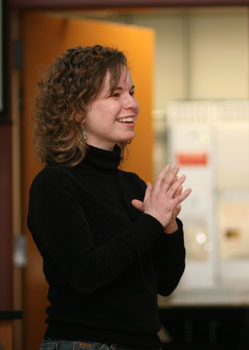 Assistant Professor of Biology Amanda Ingram’s research on chloridoid grasses got a major boost in September when the National Science Foundation awarded her a four-year grant of more than $217,000.
Assistant Professor of Biology Amanda Ingram’s research on chloridoid grasses got a major boost in September when the National Science Foundation awarded her a four-year grant of more than $217,000.
Ingram will collaborate with Claremont Graduate University Associate Professor Travis Columbus, a research scientist at the Rancho Santa Ana Botanic Gardens in Claremont, California.
Chloridoid grasses include 1,500 largely warm-season, tropical, and subtropical species in 150 genera, including economically important species grown as cereal crops and a variety of turf grasses. These grasses have tremendous variation in the arrangement of their flowers (inflorescence).
“Despite the economic importance of some of these grasses, relatively little is known about the relationships among the species or the genetic regulation of inflorescence development,” Ingram says. “These issues will be addressed through our research.”
Ingram will focus her work on a tribe of chloridoid grasses known as Eragrostidae and will employ two Wabash summer interns in each of the next four years. She even hopes to involve Wabash students in the work at Rancho Santa Ana.
Fieldwork will be another important component of the project. During the 2010-2011 school year, Ingram and Columbus hope to spend five months collecting plant materials in Namibia, South Africa, Tanzania, and India.
“Amanda Ingram’s success in landing an NSF grant in an intensely competitive environment is a tribute to her quality of mind and research,” says Dean Gary Phillips. “Her commitment to teaching excellence, coupled with substantive research with students, is Wabash teaching at its best: engaged, demanding, face-to-face. This is the faculty presence that marks Wabash teaching, teaching that makes a difference in students’ lives.”
 Assistant Professor of Biology Amanda Ingram’s research on chloridoid grasses got a major boost in September when the National Science Foundation awarded her a four-year grant of more than $217,000.
Assistant Professor of Biology Amanda Ingram’s research on chloridoid grasses got a major boost in September when the National Science Foundation awarded her a four-year grant of more than $217,000.